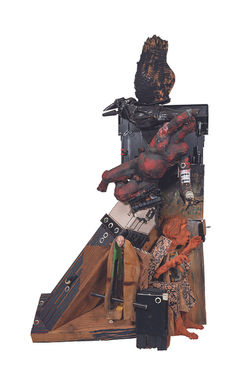 |  |  |  |  |  |
|---|---|---|---|---|---|
 |  |  |  |  |
David Olivant
The main themes that emerge from my art concern the struggle to make genuine contact with any other locus of consciousness, including our own. My work constantly fuses disparate elements and levels of reality and in doing so seeks to generate unfamiliar emotional states that are created by radical ontological uncertainty. It is this unfamiliarity that I hope provides a shock to the everyday complacency that blunts attempts at contact. Central to the assemblages (heteroglyphs) and more recent flat works (retroglyphs) is disruption of viewers’ expectations of just what it is they are actually looking at. This disruption is not a game or intellectual/perceptual conundrum, such as we might find in Op art, some Surrealism or the works of Max Escher.
The layers, references and constant hybridization should give the sense of a constant reconfiguring of boundaries, so that we realize we never know on what level we might ultimately take any statement and in so doing relinquish the need for conventional certainties that tend to impede openness. The viewer should be absorbed into the act of generating fresh but constantly sliding meanings or viewpoints rather than encouraged to seek a resolution. It is in this way that images might gain their sense of distinctness, uniqueness, or particularity. The writings of the Russian linguistic theorist, Mikhail Bakhtin and his notions of polyphony and ‘dialogicity’ have been influential for
me in this regard.
The ontological uncertainty is compounded by temporal compaction. By this I mean that my heteroglyphs contain actual and virtual fragments of neglected artworks I produced up to twenty years earlier so that I constantly reference or quote from my own practice. This is inspired by similar sleights of hand in the music of Dmitry Shostakovich, a composer whose use of sarcasm and parody to heighten emotion has
greatly influenced the emotional tenor of my own work. This temporal compaction has come to a head in my retroglyphs which are all performed over large-scale high-res digital photographs of my earlier heteroglyphs, thus greatly compounding temporal elisions and fractures, messing with autobiography and history and creating an orgy of anachronism! The complex layered process forces an often unsought for reflection on much earlier “outdated” parts of my oeuvre. These are recontextualized in the present moment thus re-configuring my own memories, particularly those that pertain to the making of art.
David Olivant holds an M.A. in Painting from the Royal College of Art in London and a B.A.in Art from the Falmouth School of Art. He has served as a Professor of Art at California State University, Stanislaus since 1995. His work has been exhibited across the US and internationally in Asia and Europe. The artist is based in Santa Fe, NM.

